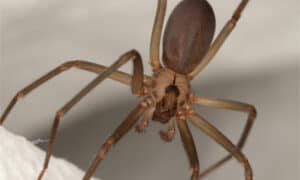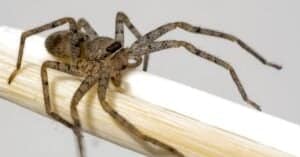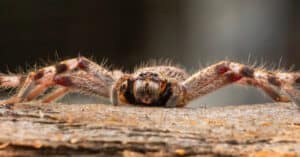Meet the Goliath Tarantula
Humans are built with an innate fear of spiders, instilled in us by evolution as a means to protect us against some of our most credible threats in the wild. And there’s never been better proof of why than the aptly named Goliath Tarantula. This is the world’s largest spider, and it’s earned the lovely sobriquet of “Bird-Eating Spider”. The habits of this tarantula may seem alien on the surface, but you can be assured that even this spider has a role to play in the ecosystems it inhabits. Here’s everything you need to know about the South American rainforest’s terrifying bird-eating spider.
Goliath Tarantula Size and Physiology
The Goliath Tarantula is recognized as the world’s largest spider species with a maximum leg span of 12 inches and a body length of nearly five inches. To put things in perspective, this spider’s body alone is over twice the length of the bee hummingbird — a Cuban species that’s also the world’s smallest bird. They can also grow to be over six ounces or roughly a third of a pound.
Females of the species are both larger than males and have significantly longer lifespans. While the average male will only live to ages between three and six, a female Goliath tarantula can live for a quarter of a century in the wild. That extended lifespan accounts in part for the larger size of females. These spiders have exoskeletons rather than traditional skeletons, and they molt multiple times throughout their lifetime. It’s a process that allows for them to continue maturing, but it also allows them to recover lost limbs.
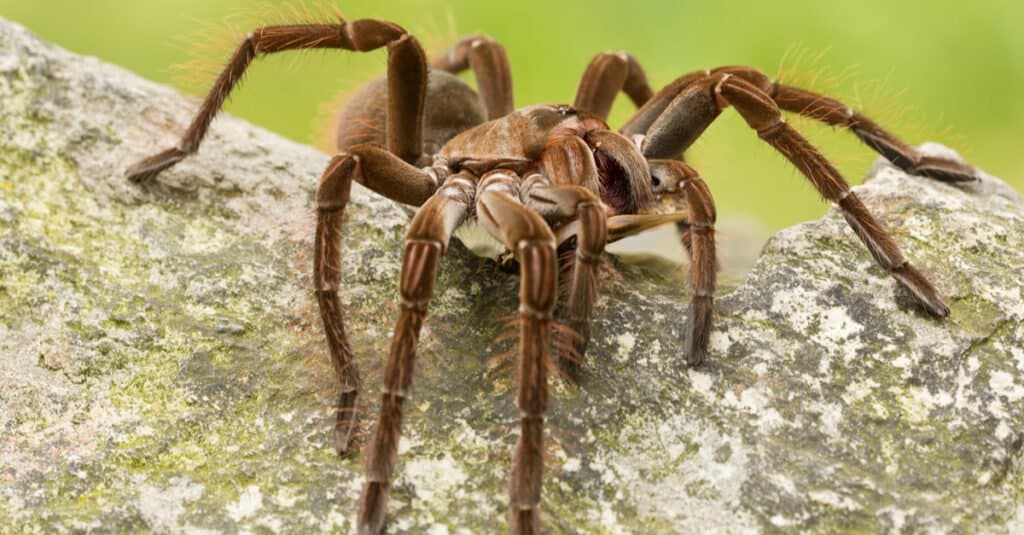
©Milan Zygmunt/Shutterstock.com
Goliath Tarantula Diet
Considering its title as the bird-eating spider, birds make up a surprisingly small part of the Goliath tarantula’s diet. There’s no definitive proof that these spiders even eat birds — though bird eggs are a relatively consistent part of their diet. Members of the species at the Smithsonian Museum are fed on a diet of cockroaches, though these spiders have been known to eat everything from earthworms and insects to small rodents and lizards to the rare bat.
This spider is certainly capable of bringing down a bird — but modern, documented evidence of it hasn’t been presented. This comes down to the fact that these spiders do most of their hunting on the forest floor, leaving most birds out of reach but leaving some opportunities to pillage nests. If there’s a creature even slightly smaller than this tarantula within reach, you can be practically certain the spider will treat it as food.
How the “Bird-Eating Spider” Got Its Name
The Goliath tarantula earned its unique moniker based not on documented fact but by its interpretation in a piece of art. Instead, it was given the name after an 18th-century engraving of the tarantula devouring a hummingbird was created by muralist German naturalist and artist Maria Sibylla Merican. But despite indications that this spider rarely, if ever, feeds on birds, it’s a name popular enough to stick — and to continue to spread the dangerous mystery that lingers around this species.
Goliath Tarantula Hunting and Defensive Habits
The eight eyes on this species are more intimidating than they are useful. Nearly blind, this tarantula is also incapable of smelling or hearing its prospective prey. Instead, they make use of those terrifying trademark hairs that line their eight long legs. Similar to how a cat’s whiskers work, these hairs sense vibrations in the air and transmit them to the spider as surprisingly sophisticated data. It’s a method of sense that’s surprisingly effective, allowing the spider a wide understanding of its surroundings without making itself known by either predators or prey. But those bristly hairs also function as defensive tools.
The tarantula spider can rub together the spines to create surprisingly loud hissing sounds — capable of being heard up to 15 feet away — to chase off predators. They can even launch these bristles at potential attackers as a last resort.
Naturally, this spider takes advantage of its unique sensory skills to operate as an ambush predator — getting ahead of its prey and letting them come to it rather than actively chasing prey. Once prey is in reach, it’s hard to resist. The inch-long fangs of this spider are hollow, essentially serving as syringes that can inject toxins directly into the bloodstream of prey. These toxins essentially liquefy the prey from the inside out. From there, the massive spider can either devour its prey on the spot or drag it back to its burrow to feast.
And while the Goliath spider will bear its fangs as a threat when cornered by humans, it’s a mostly empty one. These spiders will only attack humans in self-defense and will generally not inject toxins if they do bite. In instances where humans have been poisoned, the sting resembled the severity of a wasp sting — an annoyance but hardly life-threatening.
Goliath Tarantula Social Behaviors
Goliath spiders live solitary lives except during periods of mating. And while it’s common for female tarantulas to devour males after mating, that’s not the case with the goliath. Despite this, males naturally tend to expire only shortly after reaching sexual maturity. They’ll typically die a few months after passing on their reproductive materials.
A female will lay between 50 and 200 eggs, but they’re more hands-on mothers than other spiders. After laying the eggs, she’ll simply wrap them up into a ball and carry them with her wherever she goes. A full sack of these eggs can reach roughly the size of a tennis ball. As she raises her young, they’ll go through multiple different molts before reaching full size. It will take two to three years for them to reach the near-foot-long reach they’ll have as fully mature adults.
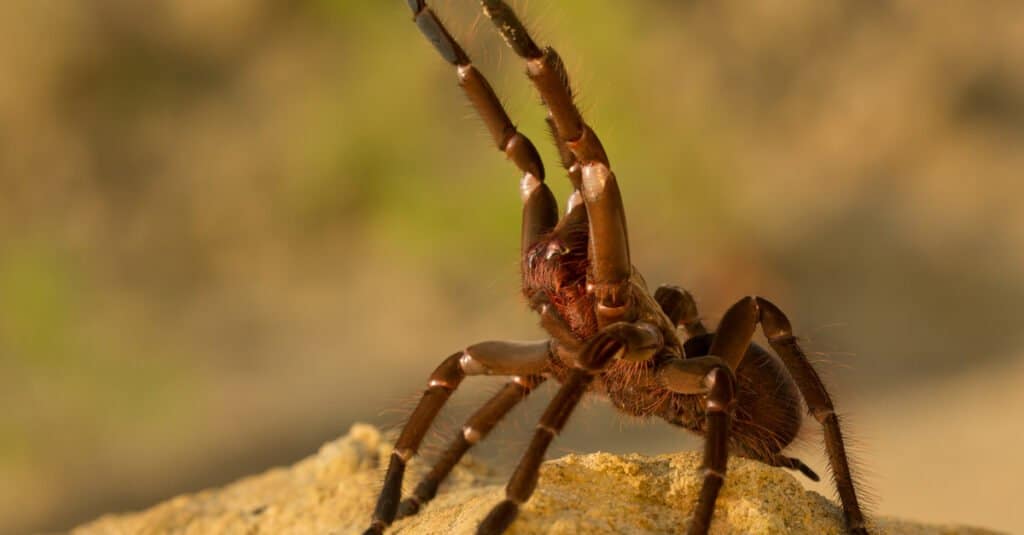
©Milan Zygmunt/Shutterstock.com
Goliath Tarantula Habitat
This species of spider can be found exclusively in the swamps and rainforests of South America. Habitats can be found throughout Guyana, Brazil, Venezuela, French Guiana, and Suriname. The dense vegetation offers countless opportunities both for camouflage and for prey. These spiders will often commandeer the existing burrows of mice to use as their nests and ambush points. Despite its large size, the mossy and heavy carpet throughout these regions allows them to blend into the environment around them without any preparation. If no existing burrows are available, these spiders will dig their own in the soft mud of their surroundings.
While these spiders are only native to South America, they’re sometimes chosen as exotic pets by specialized collectors. But they haven’t managed to gain a great deal of traction in the community, as these tarantulas tend to be more aggressive than some of their tamer brethren. The bird-eating spider is also considered a delicacy in native cuisine. It’s prepared by gingerly removing the rough hairs from its legs before roasting it in a banana leaf.
Other Bird-Eating Spider Breeds
The Goliath tarantula may not quite live up to its name as a bird-eating spider, but other species are ready to step up to the plate. Documented footage has shown a pink-toed tarantula — a species quite similar to the Goliath tarantula — in the process of eating a wren whole. Australia’s great huntsman spider is also known to make small birds a part of its diet. A member of this species has even been seen devouring a pygmy possum. The difference between their eating habits and that of the goliath tarantula is merely a difference in opportunities. Pink-toed tarantulas will lurk above their prey in trees and rafters, and the great huntsman is known as a tree-climbing species as well.
Up Next…
Keep reading these posts for more incredible information about key animal facts.
- Goliath Spider vs Camel Spider: 8 Key Differences Between Them: They’re both arachnids but aren’t quite the same. One lives longer, can dry bite, and prefers a humid, forested habitat. Find out which one it is.
- Wolf Spiders: Extremely adaptable, they stalk their prey like the feared predators for whom they are named. They also enjoy excellent vision and spin elaborate webs to catch their dinner. Find out more about this intriguing hunter.
- Discover the Largest Wolf Spider Ever: This variety has gotten to outstrip all its relatives in terms of sheer size. Find out how just how large it grows and how it compares to other arachnids of impressive size.
The photo featured at the top of this post is © Milan Zygmunt/Shutterstock.com
Thank you for reading! Have some feedback for us? Contact the AZ Animals editorial team.



